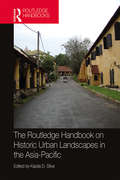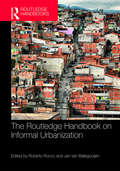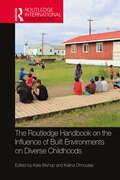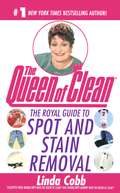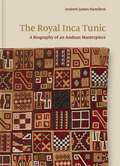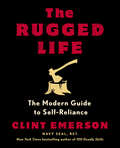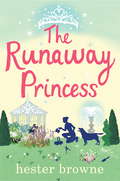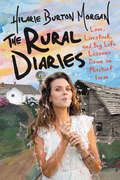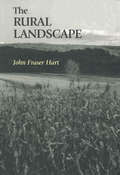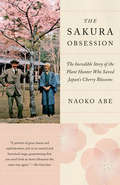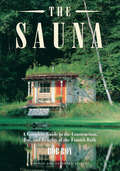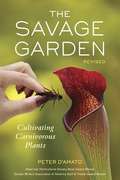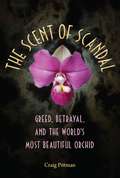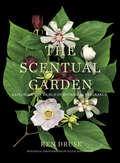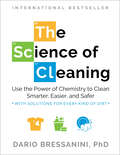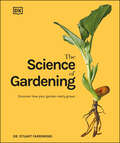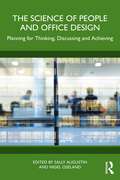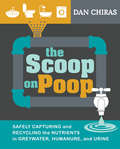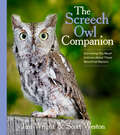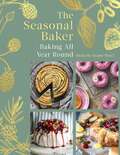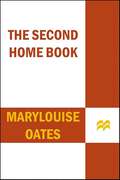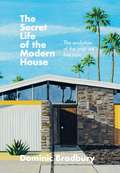- Table View
- List View
The Routledge Handbook on Historic Urban Landscapes in the Asia-Pacific (Routledge International Handbooks)
by Kapila SilvaThe Routledge Handbook on Historic Urban Landscapes in the Asia-Pacific sheds light onto the balancing act of urban heritage management, focusing specifically on the Asia-Pacific regions in which this challenge is imminent and in need of effective solutions. Urban heritage, while being threatened amid myriad forces of global and ecological change, provides a vital social, cultural, and economic asset for regeneration and sustenance of liveability of inhabited urban areas worldwide. This six-part volume takes a critical look at the concept of Historic Urban Landscapes, the approach that UNESCO promotes to achieve holistic management of urban heritage, through the lens of issues, prospects, and experiences of urban regeneration of the selected geo-cultural context. It further discusses the difficult task that heritage managers encounter in conceptualizing, mapping, curating, and sustaining the plurality, poetics, and politics of urban heritage of the regions in question. The connective thesis that weaves the chapters in this volume together reinforces for readers that the management of urban heritage considers cities as dynamic entities, palimpsests of historical memories, collages of social diversity, territories of contested identities, and sites for sustainable liveability. Throughout this edited collection, chapters argue for recognizing the totality of the eco-cultural urban fabric, embracing change, building social cohesion, and initiating strategic socio-economic progress in the conservation of Historic Urban Landscapes. Containing thirty-seven contributions written by leading regional experts, and illustrated with over 200 black and white images and tables, this volume provides a much-needed resource on Historic Urban Landscapes for students, scholars, and researchers.
The Routledge Handbook on Informal Urbanization
by Roberto Rocco Jan Van BallegooijenThe Routledge Handbook on Informal Urbanization investigates the mutual relationship between the struggle for political inclusion and processes of informal urbanization in different socio-political and cultural settings. It seeks a middle ground between two opposing perspectives on the political meaning of urban informality. The first, the ‘emancipatory perspective’, frames urban informality as a practice that fosters autonomy, entrepreneurship and social mobility. The other perspective, more critical, sees informality predominantly as a result of political exclusion, inequality, and poverty. Do we see urban informality as a fertile breeding ground for bottom-up democracy and more political participation? Or is urban informality indeed merely the result of a democratic deficit caused by governing autocratic elites and ineffective bureaucracies? This book displays a wide variety of political practices and narratives around these positions based on narratives conceived upon specific case cities. It investigates how processes of urbanization are politicized in countries in the Global South and in transition economies. The handbook explores 24 cities in the Global South, as well as examples from Eastern Europe and East Asia, with contributions written by a global group of scholars familiar with the cases (often local scholars working in the cities analyzed) who offer unique insight on how informal urbanization can be interpreted in different contexts. These contributions engage the extreme urban environments under scrutiny which are likely to be the new laboratories of 21st-century democracy. It is vital reading for scholars, practitioners, and activists engaged in informal urbanization.
The Routledge Handbook on the Influence of Built Environments on Diverse Childhoods (Routledge International Handbooks)
by Kate Bishop Katina DimouliasChildren and young people are often discussed as if they are homogenous groups. The reality is, of course, very different, with an enormous variation within each of these groups and in any domain of experience pertaining to childhood or adolescence. Driven by personal, sociocultural, geographic, or economic circumstances, many children and young people worldwide are experiencing a totally different reality to those who fit with more mainstream patterns of childhood. This has substantial implications for their sociophysical environmental experience and our understanding of their physical environmental needs. The aim of this book is to draw attention to these alternate realities for a number of these groups of children and young people, highlighting the unique and different considerations associated with their particular circumstances in each instance, and identifying the repercussions for their physical environmental needs. Ultimately, this book creates an evidence-based discussion which can be used by designers, planners and policy makers, and those delivering services and programs to children and young people as a basis to make informed decisions on how to work with the groups of children and young people in our book for better environmental provision.
The Royal Guide to Spot and Stain Removal
by Linda Cobb"Out, damned spot!"For some, it's an obsession. For the Queen of Clean® it's a snap! Now you can tame even the most vexing spots and stains with this handy pocket guide, drawn from the royal bestsellers Talking Dirty with the Queen of Clean® and Talking Dirty Laundry iwith the Queen of Clean®. Here are Her Majesty's most sought-after stain removal secrets -- in one portable companion!Banish Stubborn Stains:mustardwinespaghetti saucelipstickgrass stainschewing guminkchocolategreasetarrustnail polishcoffee and teaand so many more!Discover Magical Solutions:Lemon juice, shampoo, salt, vinegar, and other inexpensive, effective spot treatments make light work -- and are waiting in your pantry!Pamper Your Washables:From silk sheets to cotton tees, wool sweaters to suede jackets, consult the Queen's sage advice on fabric types -- and lift stains from all your belongings with tender loving care!
The Royal Inca Tunic: A Biography of an Andean Masterpiece
by Andrew James HamiltonThe hidden life of the greatest surviving work of Inca artThe most celebrated Andean artwork in the world is a five-hundred-year-old Inca tunic made famous through theories about the meanings of its intricate designs, including attempts to read them as a long-lost writing system. But very little is really known about it. The Royal Inca Tunic reconstructs the history of this enigmatic object, presenting significant new findings about its manufacture and symbolism in Inca visual culture.Andrew James Hamilton draws on meticulous physical examinations of the garment conducted over a decade, wide-ranging studies of colonial Peruvian manuscripts, and groundbreaking research into the tunic&’s provenance. He methodically builds a case for the textile having been woven by two women who belonged to the very highest echelon of Inca artists for the last emperor of the Inca Empire on the eve of the Spanish invasion in 1532. Hamilton reveals for the first time that this imperial vestment remains unfinished and has suffered massive dye fading that transforms its appearance today, and he proposes a bold new conception of what this radiant masterpiece originally looked like.Featuring stunning photography of the tunic and Hamilton&’s own beautiful illustrations, The Royal Inca Tunic demonstrates why this object holds an important place in the canon of art history as a deft creation by Indigenous women artists, a reminder of the horrors of colonialism, and an emblem of contemporary Andean identity.
The Rugged Life: The Modern Guide to Self-Reliance
by Clint EmersonBecome self-reliant, live off the land, and be prepared for the unexpected in this modern guide to self-sufficiency and homesteading from New York Times bestselling author, retired Navy SEAL, and survival skills expert Clint Emerson.&“Add The Rugged Life by former Navy SEAL Clint Emerson to your library today and get on the path to independence and self-sufficiency.&”—Jack Carr, Navy SEAL Sniper and #1 New York Times bestselling author of The Devil&’s HandClint Emerson is the go-to expert for surviving the first minutes, hours, and days of a crisis. Now, in The Rugged Life, he works with modern homesteading experts to show you how to thrive over the long-term—for months, years, or even a lifetime—by being prepared and self-sufficient. You can live the Rugged Life completely off-the-grid by farming your own food and using the waste from your toilet for compost. Or, you can live it by adding solar panels to your suburban home and keeping chickens and bees in your backyard. You can even live the Rugged Life in a city by simply gathering the salad for tonight&’s dinner from your windowsill garden. Each of these homesteading and prepper long-term survival skills stand on their own, and taken together, they can help you design the independent life you want for yourself and your family. • Be your own homesteader: Make your own shampoo and face creams; pickle and ferment food; make natural bug spray and cleaning products; smoke meat; tan a hide• Be your own protector: Create a last-resort emergency plan; gather medicinal plants; protect against dangerous animals and threats; understand survival first aid• Be your own provider: Hunt for game; make a gillnet; set snares; forage for wild foods; build a rabbit hutch; ice fish; butcher a pig; keep bees• Be your own builder: Retrofit a van; set up solar, microhydro, and geothermal power; create a water catchment and filtration system; build a shipping container home• Be your own farmer: Grow a victory garden; build a greenhouse; waffle garden to save space and resources; build a root cellar; can, dry, and store crops; operate a tractor With hundreds of step-by-step, illustrated, self-sustaining skills and projects, The Rugged Life is for everyone who feels they can use more adventure, freedom, and choice in their life—everyone ready to get out of their comfort zone and try new, hard, profoundly rewarding things.
The Runaway Princess: a feel-good and heart-warming comedy for all true romantics
by Hester BrowneLove is hard enough without worrying if your tiara's straight . . .Amy Wilde is tired of the idiots her glamorous flatmate Jo tries to set her up with - she'd much rather be landscaping a garden with her dog Badger at her side than trying to find the man of her dreams. That is, until she meets Leo Wolfsburg. Handsome, polite, funny, intriguing - Leo is everything Amy could want in a man. Best of all, the attraction seems mutual.But Leo's lifestyle is a world away from her own. Private planes, charity balls, exclusive members' clubs . . . They're from two different worlds, but is that enough to keep them apart?'An adorable heroine, divine hero and gorgeous writing - basically, it's just perfect' JILL MANSELL'Clear your diary and turn off your phone. Prince Harry can call you back later . This is a book you won't want to put down' CHRISSIE MANBYREADERS LOVE THE RUNAWAY PRINCESS'This has everything: emotion, wit, real life and true romance' *****'Ended up staying all night reading it' *****'Fantastic from start to finish' *****'Perfect escapism' *****'Good old-fashioned romance complete with a Prince Charming' *****
The Rural Diaries: Love, Livestock, and Big Life Lessons Down on Mischief Farm
by Hilarie BurtonThe beloved actress and star of One Tree Hill, White Collar, and Lethal Weapon, Hilarie Burton Morgan, tells the story of leaving Hollywood for a radically different kind of life in upstate New York with her husband Jeffrey Dean Morgan—a celebration of community, family, and the value of hard work in small town America. <P><P>While Hilarie Burton Morgan's hectic lifestyle as an actress in New York and Los Angeles gave her a comfortable life, it did not fulfill her spiritually or emotionally. After the birth of their first son, she and her husband Jeffrey Dean Morgan, the star of The Walking Dead, decided to make a major change: they bought a working farm in Rhinebeck, New York, and began a new chapter in their lives. <P><P>The Rural Diaries chronicles her inspiring story of farm life: chopping wood, making dandelion wine, building chicken coops. Burton looks back at her transition from urban to country living—discovering how to manage a farm while raising her son and making friends with her new neighbors. <P><P>She mixes charming stories of learning to raise alpacas and buying and revitalizing the town’s beloved candy store, Samuel’s Sweet Shop, with raw observations on the ups and downs of marriage and her struggles with secondary infertility. Burton also includes delicious recipes that can be made with fresh ingredients at home, as well as home renovation and gardening tips. <P><P>Burton’s charisma, wide eyed attitude, and fortitude—both internal and physical—propels this moving story of transformation and self-discovery. The Rural Diaries honors the values and lifestyle of small-town America and offers inspiration for anyone longing to embark on their own unconventional journey. <p><p><b>A New York Times Bestseller</b>
The Rural Landscape
by John Fraser HartFrom the acclaimed landscape historian and geographer, a comprehensive handbook to understanding the elements that make up the rural landscape.Selected by Choice Magazine as an Outstanding Academic TitleIn this book, John Fraser Hart offers a comprehensive handbook to understanding the elements that make up the rural landscape—those regions that lie at or beyond the fringes of modern metropolitan life. Though the last two centuries have seen an inversion in the portion of people living on farms to those in cities, the land still beckons, whether traversed in a car or train, scanned from far above, or as the locus of our food supply or leisure. The Rural Landscape provides a deceptively simple method for approaching the often complex and variegated shape of the land. Hart divides it into its mineral, vegetable, and animal components and shows how each are interdependent, using examples from across Europe and America. Looking at the land forms of southern England, for instance, he comments on the use of hedgerows to divide fields, the mineral or geomorphological features of the land determining where hedgerows will grow in service of the human animal's needs. Hart reveals the impact on the land of human culture and the basic imperative of making a living as well as the evolution of technical skills toward that end (as seen in the advance of barbed wire as a function of modern transportation).Hart describes with equal clarity the erosion of land to form river basins and the workings of a coal mine. He charts shifting patterns of crop rotation, from the medieval rota of food (wheat or rye), feed (barley or oats), and fallow (to restore the land) to modern two-crop cycle of corn and soybeans, made possible by fertilizers and pesticides. He comments on traditions of land division (it is almost impossible to find a straight line on a map of Europe) and inventories a variety of farm structures (from hop yards and oast houses to the use of dikes for irrigation). He identifies the relict features of the landscape—from low earthen terraces once used in the southern United States to prevent erosion to old bank buildings that have become taverns and barns turned into human homes. Carrying the story of the rural landscape into our frantic era, he describes the "bow wave"where city life meets rural agriculture and plots the effect of recreation and its structures on the look of the land.
The Sakura Obsession: The Incredible Story of the Plant Hunter Who Saved Japan's Cherry Blossoms
by Naoko AbeThe remarkable 1,200-year history of the Japanese cherry blossom tree--and how it was saved from extinction by an English gardener.Collingwood "Cherry" Ingram first fell in love with the sakura, or cherry tree, when he visited Japan on his honeymoon in 1907. So taken with the plant, he brought back hundreds of cuttings with him to England, where he created a garden of cherry varieties. In 1926, he learned that the Great White Cherry had become extinct in Japan. Six years later, he buried a living cutting from his own collection in a potato and repatriated it via the Trans-Siberian Express. In the years that followed, Ingram sent more than 100 varieties of cherry tree to new homes around the globe, from Auckland to Washington. As much a history of the cherry blossom in Japan as it is the story of one remarkable man, the narrative follows the flower from its adoption as a national symbol in 794, through its use as an emblem of imperialism in the 1930s, to the present-day worldwide obsession with forecasting the exact moment of the trees' flowering.
The Sauna: A Complete Guide to the Construction, Use, and Benefits of the Finnish Bath, 2nd Edition
by Robert L. RoyReplete with history, tradition, health benefits, instructions for proper use and maintenance, this completely revised and expanded edition will inspire!With a history going back at least one thousand years, the sauna is ready for a new generation of enthusiasts seeking health, pleasure, and peace of mind, and Rob Roy is ready to recruit! &“If the sauna is just a bath, then Buckingham Palace is just a house.&” So writes sauna expert and intrepid do-it-yourselfer Roy in this new, updated version of The Sauna.This completely revised and expanded edition of The Sauna contains everything you ever wanted to know about the famous &“Finnish bath.&” In this inviting book, Roy shares his infectious enthusiasm for the sauna and provides a complete, detailed guide to sauna building, along with resources for equipment and supplies.The Sauna is replete with history, tradition, health benefits, instructions for proper use and maintenance, as well as step-by-step instructions for building a variety of cordwood masonry saunas and, new to this edition, conventionally wood-framed saunas. The beautiful color photographs, also new to this edition, will inspire you to create your own sauna haven.
The Savage Garden, Revised: Cultivating Carnivorous Plants
by Peter D'AmatoFor fifteen years, The Savage Garden has been the number one bestselling bible for those interested in growing carnivorous plants. This new edition is fully revised to include the latest developments and discoveries in the carnivorous plant world, making it the most accurate and up to date book of its kind. You may be familiar with the Venus flytrap, but did you know that some pitcher plants can--and do--digest an entire rat? Or that there are several hundred species of carnivorous plants on our planet? Beautiful, unusual, and surprisingly easy to grow, flesh-eating plants thrive everywhere from windowsills to outdoor container gardens, in a wide variety of climates. The Savage Garden is the most comprehensive guide to these fascinating oddities, gloriously illustrated with more than 200 color photos. Fully revised with the latest developments in the carnivorous plant world, this new edition includes: * All the basics--from watering and feeding to modern advances in artificial lighting, soil, and fertilizers. * Detailed descriptions of hundreds of plants, including many of the incredible new species that have been recently discovered and hybridized. * Cultivation and propagation information for all the plant families: pitcher plants, Venus flytraps, sundews, rainbow plants, bladderworts, and many other peculiar plants from the demented mind of Mother Nature. Whether you're a beginner with your first flytrap or an expert looking for the latest exotic specimen, this classic book has everything you need to grow your very own little garden of horrors.
The Scent of Scandal: Greed, Betrayal, and the World's Most Beautiful Orchid (Florida History and Culture)
by Craig PittmanAfter its Peruvian discovery in 2002, Phragmipedium kovachii became the rarest and most sought-after orchid in the world. Prices soared to $10,000 on the black market. Then one showed up at Marie Selby Botanical Gardens, where every year more than 100,000 people visit. They come for the lush landscape on Sarasota Bay and for Selby's vast orchid collection, one of the most magnificent in the world. <P><P>The collision between Selby's scientists and the smugglers of Phrag. Kovachii, a rare ladyslipper orchid hailed as the most significant and beautiful new species discovered in a century, led to search warrants, a grand jury investigation, and criminal charges. It made headlines around the country, cost the gardens hundreds of thousands of dollars in donations, and led to tremendous internal turmoil. <P><P>Investigative journalist Craig Pittman unravels this tangled web to shine a spotlight on flaws in the international treaties governing trade in endangered wildlife--which may protect individual plants and animals in shipping but do little to halt the destruction of whole colonies in the wild. <P><P>The Scent of Scandal unspools like a riveting mystery novel, stranger than anything in Susan Orlean's The Orchid Thief or the film Adaptation. Pittman shows how some people can become so obsessed--with beauty, with profit, with fame--that they will ignore everything, even the law.
The Scentual Garden: Exploring the World of Botanical Fragrance
by Ken DruseA complete illustrated survey of fragrant flowers and plants, from a celebrated gardening expert and an award–winning botanical photographer. Popular garden writer Ken Druse offers a complete survey of fragrance in the garden, in a major work filled with new knowledge. He arranges both familiar and unusual garden plants, shrubs, and trees into twelve categories, giving gardeners a vastly expanded palate of scents to explore and enjoy, and he also provides examples of garden designs that offer harmonious scentual delights. Ellen Hoverkamp contributes her artful botanical images of flowers and plants discussed in the text. These are accompanied by Druse’s award-winning garden photographs, to create a book that is as beautiful to look at as it is informative and evocative to read.
The Science Of Baking: (Ada Twist, Scientist: The Why Files #3) (Questioneers)
by Andrea Beaty Theanne GriffithFrom the New York Times bestselling creator of the Questioneers, Andrea Beaty, and author Theanne Griffithcomes The Science of Baking (Ada Twist, Scientist: The Why Files), a nonfiction early-reader book based on the Netflix series! <P><P> How does a cake bake? What’s the difference between baking soda and baking powder? And why is it so important to measure the different ingredients in a recipe? Ada Twist, Scientist: The Why Files is the perfect nonfiction resource for all these questions and more. Based on the bestselling series and the Netflix show, this nonfiction series is perfect for the youngest scientists of tomorrow as they learn along with Ada. Designed in a scrapbook format, these books combine art from the show, illustrations, and photography to bring simple science concepts to life.
The Science of Cleaning: Use The Power Of Chemistry To Clean Smarter, Easier, And Safer-with Solutions For Every Kind Of Dirt
by Dario BressaniniThe definitive, science-backed guide to cleaning everything in your home in a safe, sustainable, evidence-based way “A great reference for anyone stumped by reluctant-to-leave dirt—and far cheaper than hiring a professional.”—Booklist Countless cleaning hacks for every kind of household dirt may vie for our attention, but how do we know which ones really work and which ones will only leave you with a sticky mess that doesn’t actually do the job? Scientific evidence comes to the rescue, as chemistry professor Dario Bressanini teaches you everything worth knowing about cleaning agents and processes (and dispels plenty of myths, too). He answers all of our most pressing housekeeping questions: Is it more efficient to wash dishes in the sink or in the dishwasher? Does bleach remove dirt? Which cleaning supplies should I buy, and which can I make at home? Can vinegar and baking soda actually unclog your drain? How can I most effectively tackle different types of stains? What can get rid of that stuff on my showerhead? Bressanini covers subjects like these by digging into chemistry basics such as solubility, pH, and concentration, bringing them out of the classroom and into the real-world chores that we deal with every day. Laundry, dishes, sinks, bathtubs, counters, floors, and more—no matter what you’re cleaning, this book explains how to choose the right tools for the task, save yourself unnecessary effort, and stay eco-friendly by avoiding waste. The Science of Cleaning reminds us that science can be both useful and exciting. With Bressanini’s help, you can keep your home, your belongings, and yourself clean—with the confidence that only centuries of advancements in chemistry can provide.
The Science of Gardening: Discover How Your Garden Really Works
by Dr. Stuart FarrimondExploding myths and providing key takeaway advice for gardeners at any level, this book provides a shortcut to decades of gardening experience by explaining the science behind how a garden grows.How often should I water my plants? What&’s the most effective slug deterrent? Could I breed my own unique variety of flower? Do plants have intelligence? Does it really matter when and how I prune? And why is my compost heap so slimy? If you find yourself seeking the answers to these questions and many more, then this may be the book for you!The world of gardening can be a mystifying place, with so many instructions to follow and often little explanation as to why. Dr Stuart Farrimond casts his scientific eye over the garden to answer all the horticultural questions you&’ve ever wondered about.Get your gardening gloves on and dive straight in to discover:- An accessible guide structured around the life cycle of the garden, taking you from first shoots to pruning for renewal.- An accessible Q &A format, with stats and infographics to bring the story to life, as well as long-held gardening myths are exploded by new science.- Every way to greener fingers has action points so that you can understand the science, apply your gardening practice, and enjoy a flourishing garden.From hands-on, practical advice, to an exploration of the mental health benefits of gardening, whilst also covering topics such as the positive impact gardening can have on the earth during a time of climate crisis, The Science of Gardening debunks myths, and reveals the latest science often only taught at horticultural college. As a passionate newcomer to gardening, daunted by the mountain of often conflicting advice in gardening manuals, Dr Stuart Farrimond has set about testing the scientific basis of so much conventional wisdom and practice so you too can garden like a pro.A must-have gardening book for keen beginners with a passion for plants but who are daunted by the prospect of trawling through traditional gardening manuals for explanations, as well as experienced gardeners who are intrigued to find out the theory behind their practice and who want to improve on where they might be getting something wrong.At DK, we believe in the power of discovery. So why stop there? If you like Science of Gardening, then why try Science of Cooking or Science of Spice to complete the collection.
The Science of People and Office Design: Planning for Thinking, Discussing and Achieving
by Sally Augustin Nigel OselandThe Science of People and Office Design: Planning for Thinking, Discussing and Achieving has been written for practitioners who would like to apply evidence-based and human-centric design principles to office and workplace design. Practitioner-researcher disconnects often arise due to a lack of meaningful connection between their professional worlds. This book seeks to rectify this disconnect and make it clear that research can significantly affect the likelihood that design projects achieve the objectives outlined in their briefs, and that practitioners need to have a real influence on research conducted.The book consists of 16 chapters,each grouped into three major sections, with an overview chapter and a conclusion drawn together by the editors. Each chapter addresses a real-world workplace design-related issue. The first part of each chapter presents the editors' overview of the problem in practice and the objectives that must be achieved via design solutions. The second portion of each chapter presents peer-reviewed research related to the chapter’s topic, written by a researcher focused on practical issues. The final part of each chapter is written by a workplace design practitioner and details their efforts to resolve the section’s real-world workplace design-related concern by applying relevant peer-reviewed research.The book is aimed at professionals working in business, interior design, architecture, surveying, facilities management, building services engineering, human resources and psychology who are key stakeholders in the design and delivery of modern office spaces. Postgraduates studying design, architecture, engineering, facilities management, environmental psychology and wellbeing will also find the book useful.
The Scoop on Poop
by Dan ChirasFlush it and forget it is the plumbing mantra of the industrialized world. Most people just want sewage to go away, preferably without having to see, smell, or worse yet, touch it. But crap has a bad rap. Human waste is a valuable resource we can use to support food production. Blackwater, greywater, and solids are actually rich in organic matter, and alternative means of handling these "wastes" can conserve enormous quantities of fresh water for other uses.The Scoop on Poop presents a wide range of ways to answer the call of nature, and in so doing to maximize the benefits of existing waste water. This book explores proven alternatives to Western sanitation. Whether you're interested in composting toilets, outdoor grey- or blackwater planters, constructed wetlands, or other innovative solutions, author Dan Chiras will walk you through: System pros and cons Design, construction, and maintenance advice Costs, permitting issues, and the safe treatment of composted wasteAll system plans are relatively simple and straightforward enough for the average homeowner to build and install. Intended for readers who live in cities, towns and rural environments, this is a practical guide to safe, ingenious ways to capture the nutrients from waste and recycle them back into your soil to grow fruit trees, vegetables, and flowers--all without running afoul of the "ick" factor. Dan Chiras is the author of over thirty books on residential renewable energy and green building, and is the director of the Evergreen Institute's Center for Renewable Energy and Green Building.
The Screech Owl Companion: Everything You Need to Know about These Beneficial Raptors
by Jim Wright Scott WestonThis must-read for birders features a complete guide to attracting, understanding, and protecting owls. The call of an owl evokes mystery; seeing one in the wild inspires wonder. Of the top ten birds people hope to see, three are owls. Although they may be out of sight, owls are widespread throughout North America—and screech owls are the most likely to make their homes near humans. In this book, experts Jim Wright and Scott Weston show you how to attract them to nest in your yard, year after year.The Screech Owl Companion introduces screech owls, show how to distinguish them from other species, shares fun lore and legend, and provides step-by-step instructions for making your yard screech ready. You&’ll learn how to build a nest box and install a simple nest cam that you can monitor from your cell phone to watch when owls move in, lay eggs, and hatch.
The Seasonal Baker: Baking All Year Round
by Michelle Evans-FecciSeasonal bakes and tips on growing your own produce by former The Great British Bake Off contestant, Michelle Evans-FecciFormer Bake Off contestant Michelle was known on the show for her flavoursome, colourful bakes and for championing seasonal, locally sourced and homegrown produce. Whether it's a simple loaf for breakfast or a striking showstopper cake for a celebration, she loves using seasonal food to create tasty recipes for the whole family to enjoy. The Seasonal Baker is a collection of recipes straight from Michelle's kitchen to yours - from quick-and-easy bakes to others that are a bit more challenging - with an emphasis on special events such as Easter, Halloween and Christmas. Inside you will find delicious, vibrant recipes such as: - Hot Cross Bun Bread and Butter Pudding- Truffle, Rosemary and Garlic Focaccia- Smokey Pulled Pork Sausage Rolls- Butternut Squash, Feta, Maple and Pecan Cups- Vanilla, Rhubarb and Raspberry Celebration CakeMichelle grew up on a farm and learned from a young age how to grow vegetables and the basics of cooking and baking. She now lives in the beautiful seaside town of Tenby in Pembrokeshire with her husband Ben, their teenage son Alfie, little whippet Rosie, and two cheeky hens. As a family they love to be out in the garden where they grow a lot of the fruit, vegetables and herbs that Michelle uses in her everyday cooking. The book shows just how easy and rewarding it is to grow your own produce.As well as delicious bakes for all abilities, The Seasonal Baker contains hints and tips on ways of being thrifty with food. There is something for everyone, from what to plant, when to plant it and when to harvest - whether you have access to a plant pot, window box, balcony, raised bed or garden veg patch with intuitive, creative photos to help.
The Seasonal Baker: Baking All Year Round
by Michelle Evans-FecciSeasonal bakes and tips on growing your own produce by former The Great British Bake Off contestant, Michelle Evans-FecciFormer Bake Off contestant Michelle was known on the show for her flavoursome, colourful bakes and for championing seasonal, locally sourced and homegrown produce. Whether it's a simple loaf for breakfast or a striking showstopper cake for a celebration, she loves using seasonal food to create tasty recipes for the whole family to enjoy. The Seasonal Baker is a collection of recipes straight from Michelle's kitchen to yours - from quick-and-easy bakes to others that are a bit more challenging - with an emphasis on special events such as Easter, Halloween and Christmas. Inside you will find delicious, vibrant recipes such as: - Hot Cross Bun Bread and Butter Pudding- Truffle, Rosemary and Garlic Focaccia- Smokey Pulled Pork Sausage Rolls- Butternut Squash, Feta, Maple and Pecan Cups- Vanilla, Rhubarb and Raspberry Celebration CakeMichelle grew up on a farm and learned from a young age how to grow vegetables and the basics of cooking and baking. She now lives in the beautiful seaside town of Tenby in Pembrokeshire with her husband Ben, their teenage son Alfie, little whippet Rosie, and two cheeky hens. As a family they love to be out in the garden where they grow a lot of the fruit, vegetables and herbs that Michelle uses in her everyday cooking. The book shows just how easy and rewarding it is to grow your own produce.As well as delicious bakes for all abilities, The Seasonal Baker contains hints and tips on ways of being thrifty with food. There is something for everyone, from what to plant, when to plant it and when to harvest - whether you have access to a plant pot, window box, balcony, raised bed or garden veg patch with intuitive, creative photos to help.
The Second Home Book: The Can-Do, How-To, Get-Through Guide
by Marylouise OatesThe Ultimate Guide to Organize and Inspire You So You Can—Really!—Sit Back and Enjoy Your Second HomeThe Second Home Book is the first of its kind – a conversational, comprehensive and convenient guide to setting up, operating and, most of all, enjoying a second home. It is cheerful and useful—funny, fact-filled, anecdotal – appealing to both those already ensconced in or encumbered with a 2nd residence as well as those imagining a future, fantastic home.In The Second Home Book, you'll learn:--how to furnish your second home on a shoestring (without relying on castoffs from your primary residence)--how to run your second home efficiently from afar--how to assemble a dream team of helpers (from handymen to cleaning help) and keep them motivated--how to entertain (even other people's children) without exhausting yourself--why you should avoid renovating your second home's kitchen--how to handle bills, routine maintenance, and emergencies--how to turn any house into your dream houseThe Second Home Book is not about how to finance a second home—it's about absolutely everything else you need to know in one cheerful, easy-to-navigate volume.
The Secret Life of the Modern House: The Evolution of the Way We Live Now
by Dominic Bradbury* * * 'Informative and entertaining, this publication is a feast for the eyes, while also thought provoking, and offers excellent inspiration for daydreaming about what makes the perfect, modern house.' Wallpaper'A fascinating selection of innovative homes....this is a thoughtful journey through the evolution of domestic architecture.' Sunday ExpressOver the last century the way that we live at home has changed dramatically. Nothing short of a design revolution has transformed our houses and the spaces within them - moving from traditional patterns of living all the way through to an era of more fluid, open-plan and modern styles. Whether we live in a new home or a period house, our spaces will have been shaped one way or another by the pioneering Modernists and Mid-century architects and designers who argued for a fresh way of life. Architectural and design writer Dominic Bradbury charts the course of this voyage all the way from the late 19th century through to the houses of today in this ground-breaking book. Over nineteen thematic chapters, he explains the way our houses have been reinvented, while taking in - along the way - the giants of Art Deco, influential Modernists including Le Corbusier and Frank Lloyd Wright, as well as post-war innovators such as Eero Saarinen and Philip Johnson. Taking us from the 20th to the 21st century, Bradbury explores the progress of 'modernity' itself and reveals the secret history of our very own homes.
